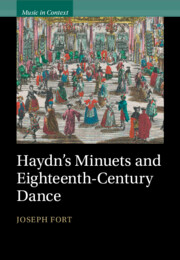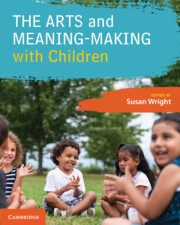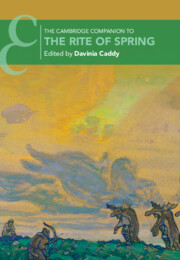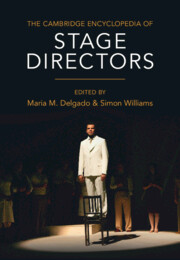Refine search
Actions for selected content:
112 results
Chapter 6 - Culturally responsive dance in the early years
-
-
- Book:
- The Arts and Meaning-Making with Children
- Published online:
- 11 September 2025
- Print publication:
- 25 September 2025, pp 113-140
-
- Chapter
- Export citation
‘I’m still using my body’ – dancing with the lived musical body: an interpretative phenomenological analysis of embodied knowledge
-
- Journal:
- Ageing & Society , First View
- Published online by Cambridge University Press:
- 22 September 2025, pp. 1-24
-
- Article
-
- You have access
- Open access
- HTML
- Export citation

Haydn's Minuets and Eighteenth-Century Dance
-
- Published online:
- 12 September 2025
- Print publication:
- 02 October 2025

The Arts and Meaning-Making with Children
-
- Published online:
- 11 September 2025
- Print publication:
- 25 September 2025
-
- Textbook
- Export citation
Chapter 4 - Learning in dance
- from Part 2 - What: the arts learning areas
-
- Book:
- Teaching the Arts
- Published online:
- 28 July 2025
- Print publication:
- 06 August 2025, pp 102-129
-
- Chapter
- Export citation
Introduction
-
- Book:
- Teaching the Arts
- Published online:
- 28 July 2025
- Print publication:
- 06 August 2025, pp 1-2
-
- Chapter
- Export citation

Teaching the Arts
- Early Childhood and Primary Education
-
- Published online:
- 28 July 2025
- Print publication:
- 06 August 2025
-
- Textbook
- Export citation
Introduction: On Criticism, Excess and Felt Response
-
-
- Book:
- The Cambridge Companion to <i>The Rite of Spring</i>
- Published online:
- 28 June 2025
- Print publication:
- 17 July 2025, pp 1-8
-
- Chapter
-
- You have access
- HTML
- Export citation
11 - Choreographic Visions and Revisions
- from Part III - Performance and Interpretation
-
-
- Book:
- The Cambridge Companion to <i>The Rite of Spring</i>
- Published online:
- 28 June 2025
- Print publication:
- 17 July 2025, pp 218-235
-
- Chapter
- Export citation

The Cambridge Companion to The Rite of Spring
-
- Published online:
- 28 June 2025
- Print publication:
- 17 July 2025

The Cambridge Encyclopedia of Stage Directors
-
- Published online:
- 19 June 2025
- Print publication:
- 03 July 2025
Conclusion
-
- Book:
- Athens, 403 BC
- Published online:
- 28 February 2025
- Print publication:
- 20 March 2025, pp 297-328
-
- Chapter
-
- You have access
- HTML
- Export citation
Tsujimura Kazuko and the Body Object
-
- Journal:
- Asia-Pacific Journal / Volume 19 / Issue 3 / February 2021
- Published online by Cambridge University Press:
- 14 March 2025, e1
-
- Article
-
- You have access
- Open access
- Export citation
Dance as Public Humanities
- Part of
-
- Journal:
- Public Humanities / Volume 1 / 2025
- Published online by Cambridge University Press:
- 17 February 2025, e55
-
- Article
-
- You have access
- Open access
- HTML
- Export citation
Chapter 4 - Philosophers of the Cabal
- from Part II
-
- Book:
- Modernism, Aesthetics and Anthropology
- Published online:
- 09 January 2025
- Print publication:
- 23 January 2025, pp 127-176
-
- Chapter
- Export citation
14 - West Side Story / Suite
- from Part III - The Legacy
-
-
- Book:
- The Cambridge Companion to <i>West Side Story</i>
- Published online:
- 09 January 2025
- Print publication:
- 09 January 2025, pp 231-251
-
- Chapter
- Export citation
21 - Reform Movements Before 1940
- from Part IV - Nationalism and Independence
-
- Book:
- Understanding Colonial Nigeria
- Published online:
- 21 November 2024
- Print publication:
- 28 November 2024, pp 455-473
-
- Chapter
- Export citation
A “Promise to Preserve Proper Decorum”: Organized Dancers, Filipino Patrons, and the Politics of Night Work in 1920s Seattle
-
- Journal:
- International Labor and Working-Class History / Volume 107 / April 2025
- Published online by Cambridge University Press:
- 29 October 2024, pp. 168-183
-
- Article
-
- You have access
- Open access
- HTML
- Export citation
Chapter 4 - Not Keeping Up
-
- Book:
- The Business of English Restoration Theatre, 1660–1700
- Published online:
- 18 October 2024
- Print publication:
- 13 June 2024, pp 127-165
-
- Chapter
-
- You have access
- Open access
- HTML
- Export citation
10 - Composing for the Stage
- from Part II - Techniques
-
-
- Book:
- The Cambridge Companion to Composition
- Published online:
- 25 May 2024
- Print publication:
- 30 May 2024, pp 153-163
-
- Chapter
- Export citation
